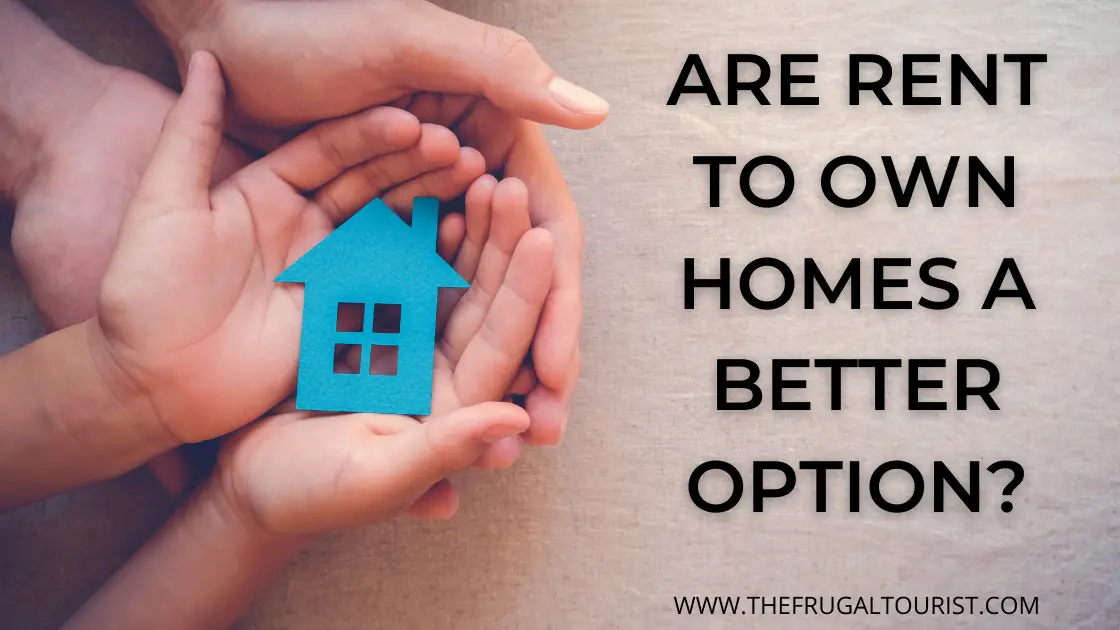Is it better to live in rent to own homes, rent, or buy our homes outright? The answer, like many questions of this nature, depends on a lot of things. Everyone’s personal circumstances are different and the decision should always be made on those circumstances.
While eating a burger at a local burger joint, here’s what a sheriff friend recently told me:
“I think I need to buy a home. I’ve been renting for a while, but feel like I’m wasting money each month on rent.”
He’s in his early 20’s itching to live the “American Dream“ but doesn’t realize that homeownership is a bit more complicated than that (we’ve been homeowners for over fifteen years).
I also understand where he’s coming from. We rented for twelve years before starting a dental practice and felt the same way as my friend each time he paid the rent.
Owning a home is a goal that many renters aspire to, but there’s a couple of things that hold them back:
- saving for a down payment
- good credit score
Enter a potential solution: The rent to own homes option.
On the surface, this sounds like a great deal. But with any financial decision, there are pros and cons to consider.
Today we’re going to discuss the basics of the rent to own homes option to determine if it’s the right fit for your situation.
How Do Rent To Own Homes Work?
Contract
There are two separate contracts to sign:
- Rental agreement
- A lease option to purchase
Rental Agreement
The rental agreement is similar to a standard lease with the rent specified, but the difference is the agreed-upon term to purchase the home potentially.
Typically this ranges from one to three years after the agreement begins.
Rent-to-Own Home Maintenance
One thing tenants should pay attention to is whether or not the landlord covers maintenance costs or not.
Occasionally the contract’s terms will state that tenants are responsible for paying for repairs and maintaining the property.
If someone is having difficulty with trying to find out this information, consider asking an attorney to review the contract.
Lease Option/Purchase
Something else to consider in the agreement is whether or not the home is a lease-purchase or lease-option.
When you first read about the two, they sound similar, but there’s a BIG difference to pay attention to.
- A lease-option is just that. It gives the tenant the option/opportunity to purchase the home before the lease is up.
- A lease-purchase legally binds the tenant, once the lease is up, to purchase the home.
My how a one-word-difference (purchase) can make a big difference!
With the lease-option, the owner gives the tenant first dibs to purchasing the home equal to the rental agreement’s lease term.
For example, if there’s a two-year lease term, then the tenant has two years to purchase without the worry of another potential buyer entering the situation.
But this comes with a cost. And that cost is called an option fee which varies anywhere from 2-7% of the home’s purchase price.
The good news is that this fee is usually credited back to the home’s purchase once the agreement is up. Unfortunately, if the tenant changes their mind and decides not to buy the house, then this money is lost.
How Much Rent Do Tenants Pay?
Everything in life is negotiable. That also applies to the rent to own homes option. Make sure you address this with the owner before signing any agreement.
It’s not uncommon for tenants to pay 15-20% more in rent as well. But remember that this “extra” amount will be credited toward the home’s future down payment.
Example
Bill signs a three-year rent to own lease for a home in an area he’d like to live for the next 15+ years.
The purchase price is $100,000, and the 3% option fee ($3,000) is due upfront.
His monthly rent is $1,000, and 20% ($200) goes toward the home’s purchase price each month.
When Bill’s three-year lease is up, we can assume the following:
The $100,000 purchase price is lowered by the $3,000 option fee, which brings the price to $97,000.
If we deduct the rent payments ($200 x 36 months), it further lowers it to $89,800.
Pros and Cons of Rent To Own Homes
Depending on which side of the deal you’re on (buyer or seller), there’s a handful of pros and cons that should be noted.
Here are a few to review:
Pros for buyers
The rent to own homes option is excellent for those that are having difficulty obtaining a mortgage the traditional way.
That involves either not having a high enough credit score for mortgage approval or a lack of adequate savings for a down payment (or both).
Those buyers that need help with one or both of the above conditions can take advantage of an extended period to build equity in the home, along with increasing their credit score.
Pros for sellers
The rent to own homes option is also beneficial to sellers too. How? For starters, they’re able to obtain a tenant that has a long-term goal of purchasing their home.
Not only will they have someone that will more than likely take care of the property as if it’s their own, but also are protected by the option fee (nonrefundable) to help offset the risk if the buyer breaks the lease.
The seller also benefits with potentially more money in their pocket as typically, the rent to own homes option comes with a higher sales price.
One other perk involves saving the commission that they’d otherwise have to pay a realtor for selling the home (typically 3-6% of the purchase price.) versus selling it the traditional way.
Cons for buyers
Remember that the lease-option gives the tenant the option to purchase the home before the lease is up. Even though this is stated in the contract, it doesn’t guarantee mortgage approval.
During the lease period, if the tenant is unable to come up with an adequate down payment and/or increase their credit score, they could lose the extra money paid toward the property.
That is why it’s essential to meet with a mortgage lender before signing any contract to know what the potential consequences could be.
Another negative that a buyer could potentially face has to do with the home’s purchase price. To obtain a fair price and help prevent a significant drop in value, researching home prices and hiring a home inspector should be completed before signing an agreement.
Something else that could easily be overlooked is the seller’s financial situation. The buyer runs the risk of losing both the money that goes towards the purchase price plus the option to buy if the seller loses the home due to poor finances.
Checking the seller’s credit report and having a title search performed ahead of time allows the buyer to see how long the seller has owned the property. Typically the longer they’ve owned it, the more equity has been built up, which makes for a better situation.
Cons for sellers
The biggest con for a seller is one of the pros of the buyer (the lease option). Let me explain further.
If the seller receives an offer for the home (full price or higher) during the lease period, then they’d have to refuse it as the tenant’s lease option gives them the first dibs to purchasing the home.
How To Find Rent-to-Own Homes
One of the best sources to find homes with the rent to own option is online.
You can try searching on sites such as:
One of the downsides with sites like these is that you have to pay a fee before detailed information is released.
Another option, which happens to be free, is Craigslist. Simply search for “rent to own” in the area you’re interested in. I tried it in my zip code, and it turned up 14 listings.
One other thing to consider is finding homes that have been sell for an extended period in an area you’d love to move to.
You have nothing to lose asking the seller whether or not they’d consider changing to a rent to own option. They may love the idea as you never know what their financial situation is. They may have already moved and are tired of paying a second mortgage for an empty home.
The worse thing they could tell you is “no”.
Final Thoughts
As someone that’s been a homeowner for close to twenty years, I understand the expenses and upkeep that goes into maintaining a home.
Yes, real estate is an investment, and it does appreciate over time but consider buying due to you wanting to make a lifestyle change versus thinking about it as an investment.
This article originally appeared on Your Money Geek and has been republished with permission.


